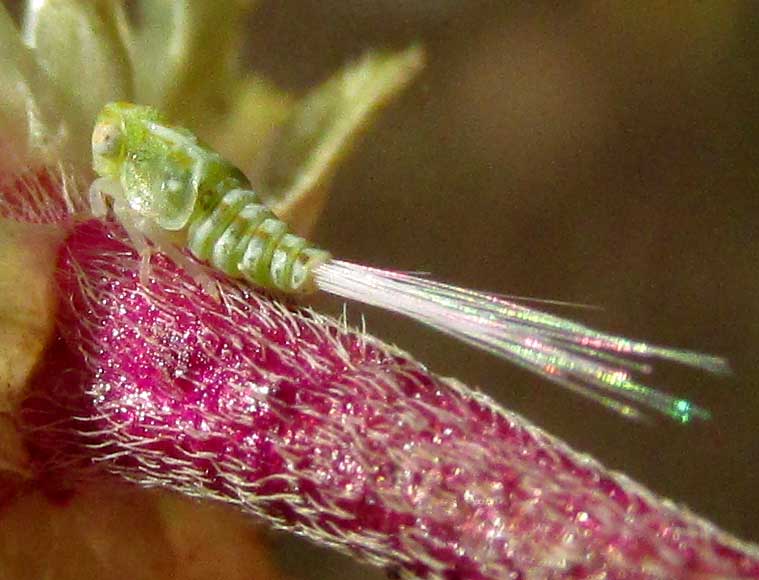Excerpts from Jim Conrad's
Naturalist Newsletter

from the January 3, 2016 Newsletter issued from Hacienda Chichen Resort beside Chichén Itzá Ruins, central Yucatán, MÉXICO
PLANTHOPPER NYMPH
While the Ruby Leaf flowering head was being photographed, an item I'd thought to be a random piece of detached plant fuzz shifted to the stem's other side, as if it were a living thing. Swiveling the camera into position, the tiny critter turned out to bear at the tip of his abdomen a tuft of hairs longer than the body itself, shown above.
With volunteer insect identifier Bea in Ontario on vacation, I figured that for me IDing such a tiny, strange creature would be hard, maybe impossible but anyway I sat about "doing the bug" the way I usually "do the botany."
First of all, what's in the picture has to be recognized as an immature stage of an insect that undergoes incomplete metamorphosis -- where what emerges from the egg looks like a small version of the adult, but with undeveloped wings and sexual parts. Such immature stages are called nymphs.
So, which of the 25 to 35 insect orders would this nymph belong to? The saddle-like covering wrapping over the back, and the bulging compound eyes on a blunt head, look grasshoppery to me, and grasshoppers belong to the order Orthoptera, so with that idea, on the Internet, a Google image-search was made on the keywords "Orthoptera nymphs."
After reviewing numerous pages of thumbnail pictures, finally something green and grasshoppery with something white sprouting from the end turned up. However, it was a planthopper nymph, and planthoppers belong the order Hemiptera, not the grasshopper's Orthoptera. Having made such an elemental mistake about the order, finding this picture was pure luck.
Up in Mississippi we've looked at an adult planthopper before, shown at www.backyardnature.net/n/a/flatid.htm.
Planthoppers are commonly encountered, smallish, often greenish or brownish insects who suck plant juices through straw-like proboscises, and sometimes hop amazing distances for such tiny creatures. They constitute a subgroup of order Hemiptera -- an "infraorder" known as the Fulgaromorpha -- of which over 12,500 species are described worldwide, with more being discovered regularly. Now it was time to do an image search on "Fulgaromorpha nymphs," and that was an eye-opening experience.
For, Fulgaromorpha nymphs, or "fulgoroids, " bear a bewildering variety of tufts and filaments on their rear ends, the arrangement depending on the species. Sometimes filaments coil about, sometimes they flair in all directions, or bend upwards or to the side, some are feathery... on and on the variations come, and if you keep browsing pages of thumbnails of Fulgaromorpha numphs, eventually you see an individual having them sticking straight out just like ours.
Based on the overall anatomy, and the tuft of straight, white filaments at the abdomen's tip, it can be said that our little nymph belongs to the family Issidae, a family occurring throughout the Northern Hemisphere, and consisting of about 1000 species in ±215 genera. And that's as far as I can go toward providing a name.
We can say that what's in the picture is an "Issid nymph," Issid being the name applied to a species in the family Issidae. In North America, Issids occur mainly in the southern states, with 18 species listed for Texas, ten for Arizona, and with states like New York and Idaho having only one, and all of New England and the upper Midwest having none.
Not much is known about Issids, other than that they suck plant juices, can perform mighty hops but generally walk across a plant's surface slowly. One reason for the lack of information is that Issidsy don't occur in large numbers so are not an agricultural threat, and thus few people study them.
With regard to the white items at the tip of the Issid nymph's abdomen, they're called abdominal filaments, and the literature describes them as wax secretions. The filaments sure don't look as if they're made of wax, but at such a small scale the laws of physics are different, so wax might behave in surprising ways. In many planthopper species wax secretions serve to camouflage the insect. Maybe my first impression -- that our Issid nymph was an errant wad of plant fuzz -- was the exact impression the nymph "wanted" to convey to predators.